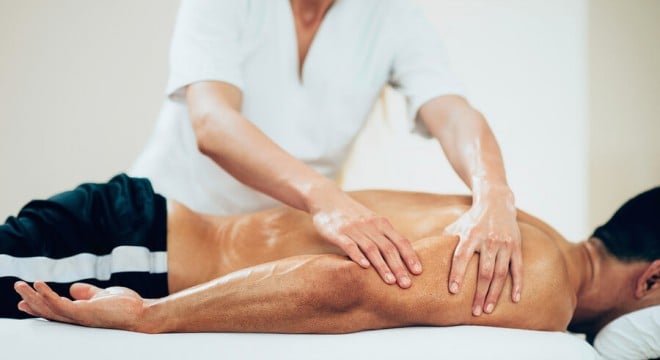The Fitness Zone

10 Benefits of Incorporating Massage Into Your Fitness Training
Most people consider exercise and diet to be the main components needed to achieve their health and fitness goals. While these are vital, other behaviours and activities can also contribute to a healthy body and mind. Massage is one such activity. AIF Massage Coach, Roberto Gaibisso, shares ten good reasons for adding massage to your life.
#1. DETOXIFICATION
Light massage strokes, such as those applied during Manual Lymphatic Drainage (MLD), encourage the body to eliminate toxins and lactic acid, which are produced during intense exercise.
#2. STRESS RELIEF
Modern life can be stressful. As technology enables us to do more, expectations around our productivity increase and we can feel as though we are never managing to get on top of things. Though it may feel as though scheduling workouts and massages around work and family demands adds to the stress, these activities can actually help to relieve tension by increasing blood flow, which carries endorphins, serotonin and dopamine which can facilitate relaxation and a sense of wellbeing.
#3. POST-WORKOUT RECOVERY
During intense exercise, high levels of strain are placed on the muscles. For muscle tissue to grow, the muscle fibres must first be broken down. To then recover and grow stronger, the muscle tissue requires a higher volume of nutrients and oxygen. Massage can help deliver these.
#4. INCREASED MUSCLE PERFORMANCE
Massage can increase muscle performance in a number of ways. When muscles are hypertonic they cannot perform at their best. As muscles tighten, they shorten, creating an ischemic reaction (a lack of blood supply to the area), which will interfere with muscle performance. Deep tissue massage can help ease the tightness, allowing the muscle fibres to perform at their best. Massage will also improve blood flow, flushing muscle tissue with oxygen and nutrients to enhance performance.
#5. INCREASED FLEXIBILITY
Massage, particularly when it incorporates stretching, can help increase the flexibility of a muscle. Joints also benefit by achieving greater range of motion, thus reducing risk of future injuries. Fascia, which is a form of connective tissue that envelops the muscles and acts as a second skin, also becomes more pliable, considerably improving flexibility.
#6. INCREASED BLOOD FLOW
Massage strokes increase the blood supply to muscles. The increased blood flow brings oxygen, water and nutrients, enabling the body to build extra muscle tissue, and also enhances waste disposal.
#7. BETTER SLEEP
Although most of the hard work is performed at the gym or park, it is during sleep that tissue repair and muscle building occur, making our downtime an important part of the recovery process. Massage can reduce the amount of tension in the muscles and promote a much deeper and more restful sleep. Numerous studies have found a link between massage and improved sleep.
#8. PAIN REDUCTION
Whether pain is experienced through an injury or overtraining, it can be debilitating. Remedial massage can be an important part of the rehabilitation process. Gentle modalities like Myofascial Release (MFR) or Muscle Energy Technique (MET) can be highly beneficial, as they can be introduced quite early in the rehabilitation protocol.
#9. DECREASED HYPERTONICITY
As muscles become overly tight or hypertonic, there is a greater chance of injury. A skilled massage therapist will be able to identify the areas of hypertonicity and release the taut bands of muscle, which will improve performance, sleep patterns and overall health.
#10. ENHANCED TRAINING ABILITY
Massage can help minimise the effects of DOMS (Delayed Onset Muscle Soreness), the post-workout ache that really kicks in the day after a hard training session. An experienced massage therapist can help decrease the discomfort experienced with DOMS, which will allow the exerciser to train more often and for longer periods.
SIGN UP FOR A MASSAGE THERAPY COURSE
Are you interested in becoming a Massage Therapist? AIF offers the following massage courses:
Read more articles
Disclaimer: Where Certificate III in Fitness, Cert III/Cert 3, or Fitness Coach is mentioned, it refers to SIS30321 Certificate III in Fitness. Where Certificate IV in Fitness, Cert IV/Cert 4, or Personal Trainer is mentioned, it refers to SIS40221 Certificate IV in Fitness. Where Master Trainer Program™ is mentioned, it refers to Fitness Essentials and SIS40221 Certificate IV in Fitness. Where Master Trainer Plus+ Program™ is mentioned, it refers to SIS30321 Certificate III in Fitness and SIS40221 Certificate IV in Fitness. Where Certificate IV in Massage or Cert IV/Cert 4 is mentioned, it refers to HLT42021 Certificate IV in Massage Therapy. Where Diploma of Remedial Massage is mentioned, it refers to HLT52021 Diploma of Remedial Massage.











